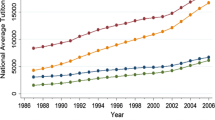Abstract.
How does competition affect higher education? This paper explores this question for public and private universities. Theory indicates that competition can push higher education policy in one of two different directions. On the one hand, competition may increase spending. For states, this would occur if states treat higher education as “developmental;” for private universities this would occur if they view spending as a means to attract students and prestige. On the other hand, competition may decrease spending if states treat higher education spending as “redistributive,” and competition may decrease spending by private schools if lower spending enhances their ability to attract students with low tuition. To determine which of these perspectives is most valid, we examine higher education policy choices in the 1980s and 1990s. We find that states appear to act as if higher education funding is “redistributive” while private schools appear to compete more on the basis of tuition than spending. These results demonstrate the important effects competition and governance structure have on higher education.
Similar content being viewed by others
Author information
Authors and Affiliations
Corresponding author
Additional information
Received: August 2001, Accepted: May 2002,
JEL Classification:
I2, I22, H72, I3
Rights and permissions
About this article
Cite this article
Bailey, M.A., Rom, M.C. & Taylor, M.M. State competition in higher education: A race to the top, or a race to the bottom?. Economics of Governance 5, 53–75 (2004). https://doi.org/10.1007/s10101-002-0052-0
Issue Date:
DOI: https://doi.org/10.1007/s10101-002-0052-0




